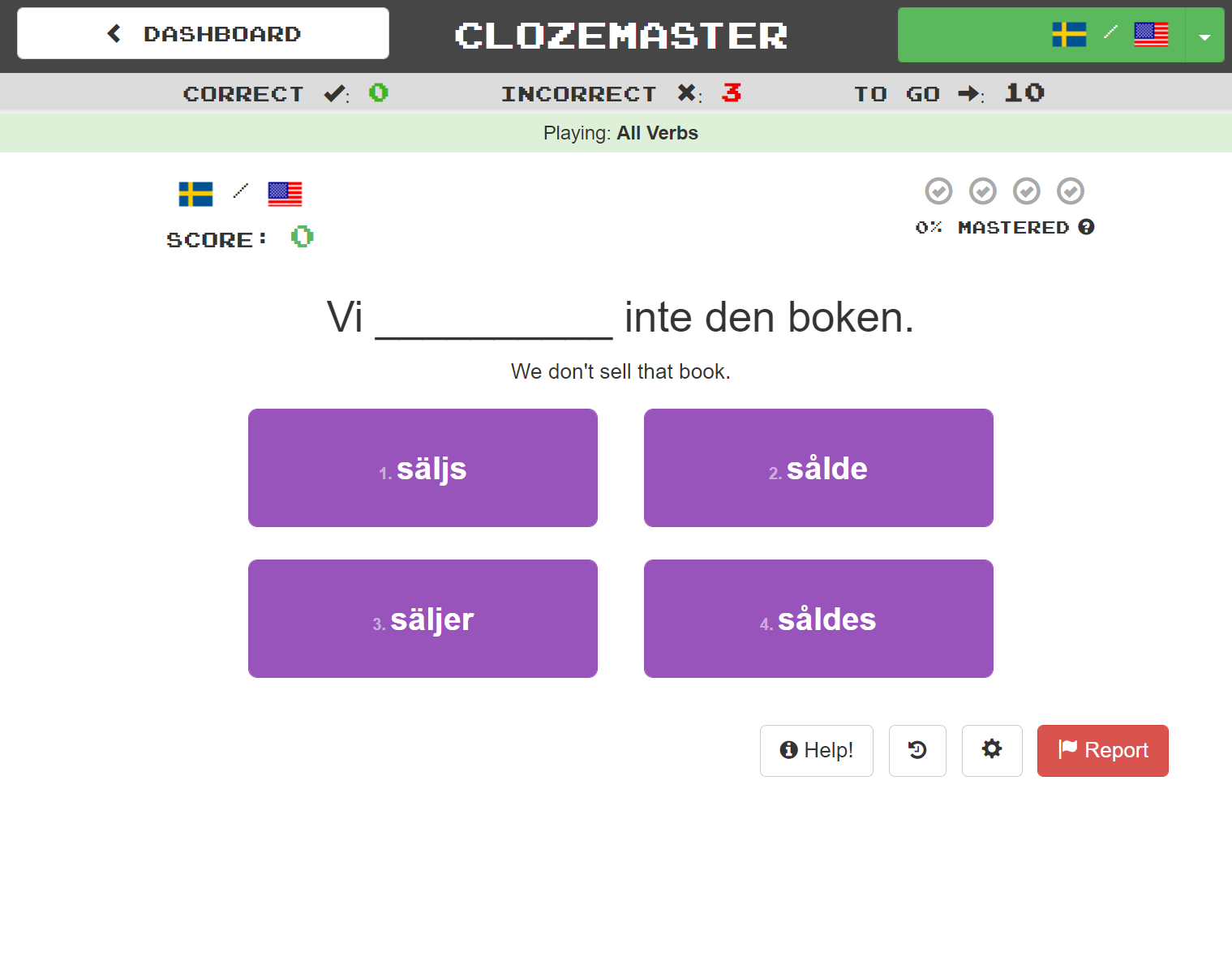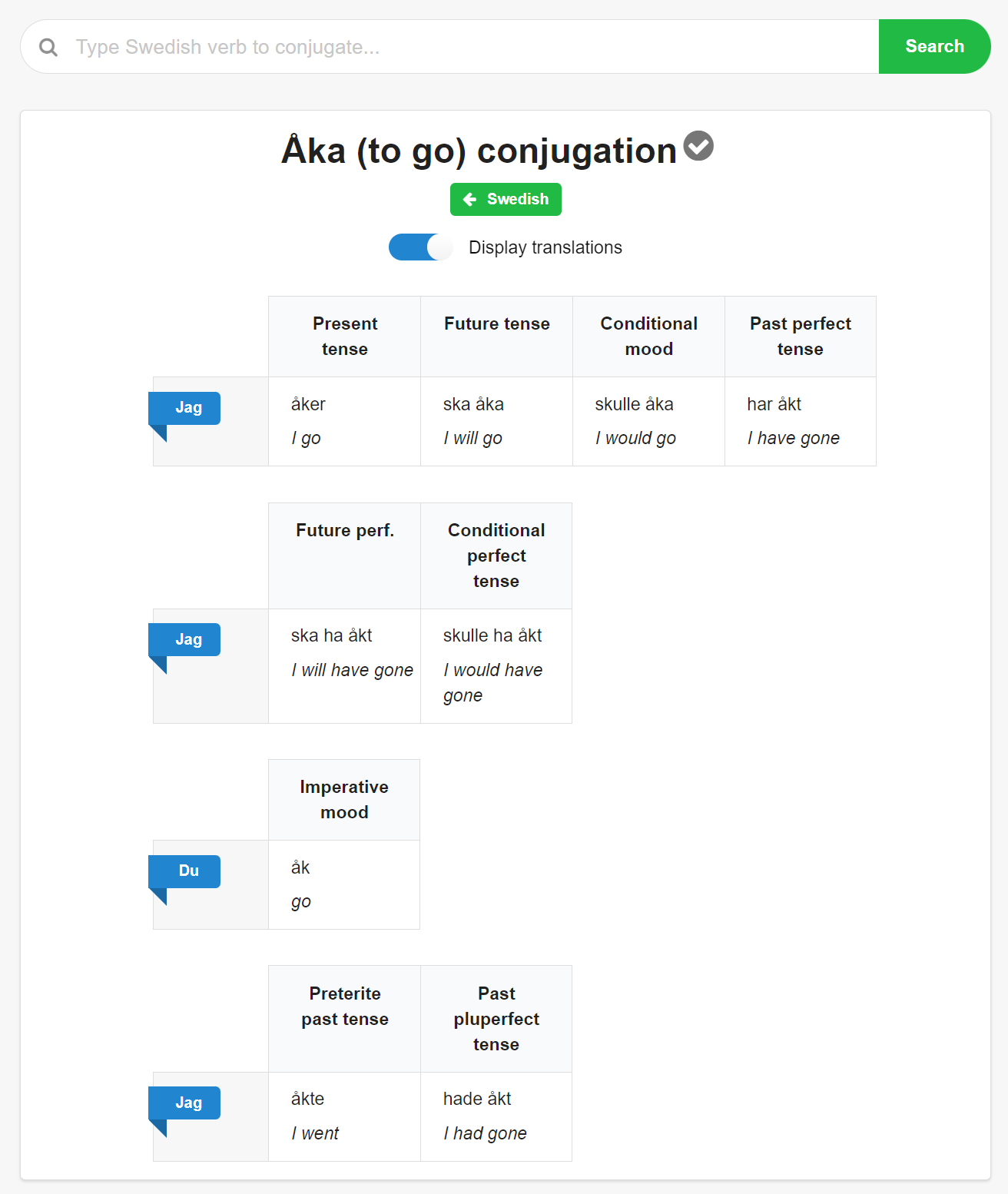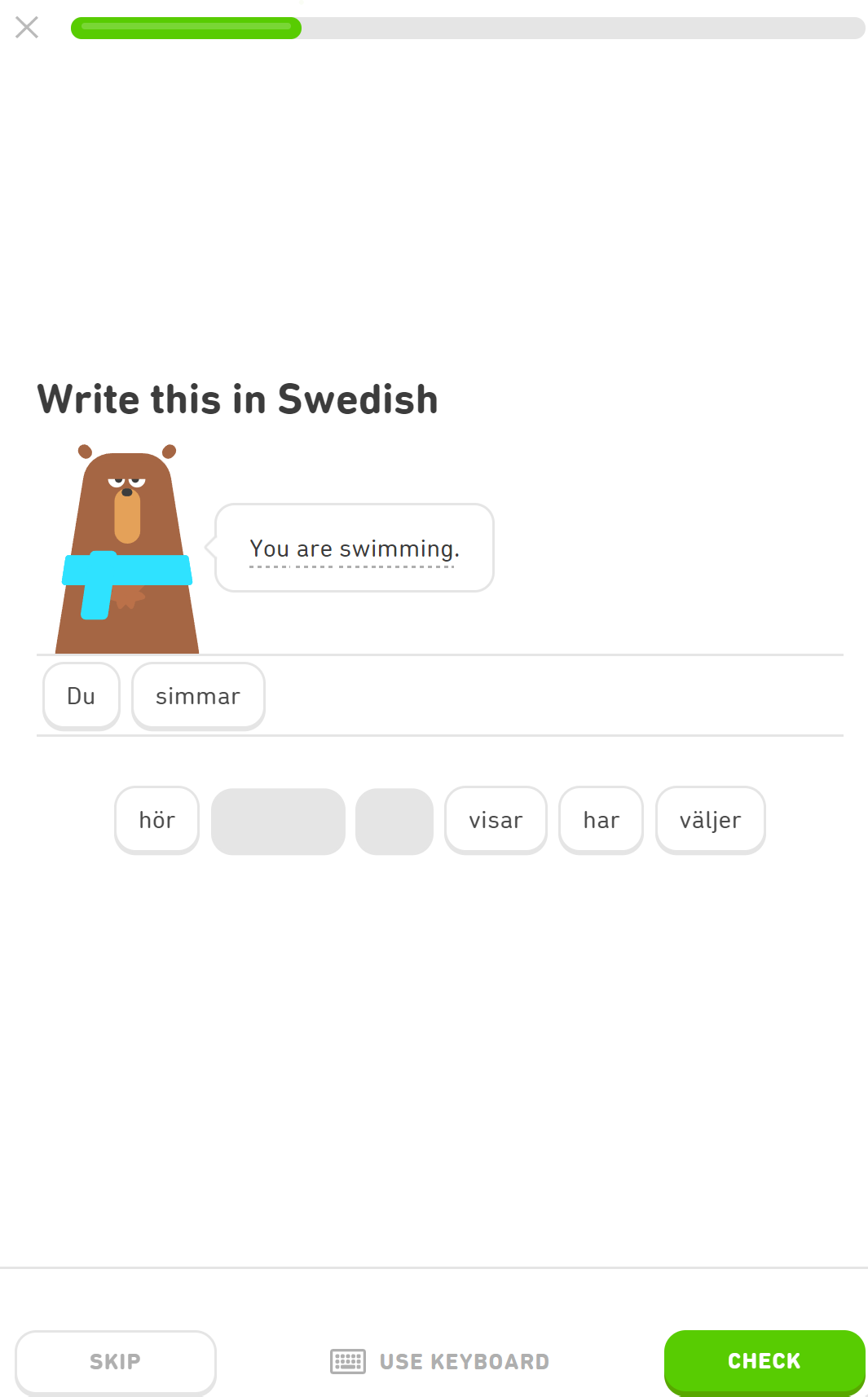
It’s not fun, we know, but it is necessary. Understanding how and when to use specific verbs is one of the main difficulties of learning a new language. Remembering how to conjugate all the verbs, both regular and irregular, will take both time and dedication. Even so, it is far from an impossibility. Take our tips and resources to get started with your Swedish conjugation practice as soon as possible.
Focus on One Thing at a Time
When you first try to learn a language, it can be tempting to dive right in and try to learn it all. Being motivated is great, though we’d suggest you put your main focus on one thing at the time. We are not telling you to ignore everything else and just do one thing. That will get boring quickly. We simply recommend you to decide on one thing to give your main focus for the time being.
For example, decide to focus on Swedish conjugation practice for a week, or decide to focus on learning common Swedish phrases for a week. Regardless of what you decide to put your energy into, your overall Swedish skills will improve. There really is no downside. Give it a shot. It might work as well for you as it has for so many other learners out there.
Don’t Just Practice and Read: Speak and Listen
Getting stuck in your books, online learning material, or practicing on your own is something that a lot of people do when learning a new language. They are afraid to throw themselves out there because of the perceived risk of embarrassment. Don’t do this. Speak and listen to Swedish-speaking people as much as you can. It’s a great way to get your Swedish conjugation practice done. You won’t even realize that it’s practice.
Real-life experience is the absolute best way for you to improve. It will improve your confidence, pronunciation, and understanding, much quicker than if you were to stay behind your computer. Learning online is great, but you need to bring your skills out in the real world.
Something that you can do if you have no Swedish speakers around is watch Swedish TV with subtitles. Sure, it is a sort of solo practice, but it is a good alternative when you don’t have the opportunity to go out and learn. Just as listening to people speak in real life, it will help you pick up words and grammar without even realizing. Practice and experience make perfect. It’s a cliché, but it’s true. You can’t get anywhere in your language learning if you don’t have the courage to throw yourself out there.
Swedish Conjugation Practice: The Basics
Both Swedish and English are Germanic languages, which means that they stem from the same language tree. They share a lot of words, and you will find that there are some other similarities. The basic rules of conjugation differ quite significantly, though.
Does Swedish Have Verb Conjugation?
Some of you might ask yourself: Does Swedish even have verb conjugation? Yes, it does. It may be tough to learn, but that makes it even more satisfying when you eventually get it right. Some parts of it are simple, as shown below, and some parts are really difficult to get right. It doesn’t take that long to master the absolute basics, so don’t be discouraged to give it a go. It might be easier than it looks at first glance.
Basic Examples of Swedish Conjugation
We’re going to give you a few basic examples just to get you started. The verb “att vara” (to be) is the verb you should learn first. It is, thankfully, also one of the easiest to learn. Mastering this simple word opens up a lot of learning opportunities that otherwise would be impossible.
| Att vara (Present Tense) | To be (Present Tense) |
| Jag är | I am |
| Du är | You are |
| Han/Hon/Det/Den är | He/She/It is |
| Vi är | We are |
| Ni är | You are |
| De är | They are |
As you can tell, the word does not change based on the subject. Learning this part is necessary for you to move on to more difficult words and conjugations. Thankfully, it’s easy to remember. Swedish verb conjugation is not based on person or gender. It is based purely on tense. This is a very important rule to remember, and will make it much easier for you in your practice.
Swedish has five tenses that you as a learner should be aware of and focus on:
- Presens (Present) — What is happening right now. I speak, I walk, etc. In Swedish, this form is also used the same way as the English present continuous form (I am speaking, I am walking, etc.)
- Preteritum (Preterite/Imperfect) — What happened before? I spoke, I walked, etc.
- Perfekt (Perfect) — What you have done. I have spoken, I have walked, etc.
- Pluskvamperfekt (Past Perfect) — What happened before another event. I had spoken (when he raised his hand), I had walked (five miles before I got to the location), etc.
- Futurum (Futurum) — What one will do in the future. I will speak, I will walk, etc.
Also important to learn is the Imperativ (Imperative or Command) form, which is the same as either the infinitive form or the verb’s stem, depending on which type of verb it is.
It might feel a bit daunting when you first see this, but don’t worry. You’ll get a hold of it with enough time and practice. However, if you are just starting out, we would recommend you to start by focusing on the present tense. Once you’ve learned a few verbs in present tense, the rest won’t be as much of a problem.
Regular Verbs
Swedish has a lot of regular verbs, meaning their endings follow the same pattern. In Swedish, a regular verb in present tense ends with either ar or er. Regular verbs in perfect tenses have endings that end with t. The specific patterns are not difficult to learn, but remember that part of learning a new verb is learning which type of endings that verb should have (or which patterns it follows).
To conjugate regular verbs in Swedish, you need to learn the stem form, which is the same as the imperative form. If the stem is the same as the infinitive (ending in an a), then you add the ar verb endings. If the stem ends with a consonant, you add the er verb endings:
Verb endings (-ar):
- Present = stem + r
- Preterite/Imperfect = stem + de
- Perfect = har + stem + t
- Past perfect = hade + stem + t
- Future = ska (or kommer att) + infinitive
Verb endings (-er):
- Present = stem + er
- Preterite/Imperfect = stem + de
- Perfect = har + stem + t
- Past perfect = hade + stem + t
- Future = ska (or kommer att) + infinitive
Some common examples of regular verbs:
| Infinitiv (Infinitive) | Imperativ (Imperative)
*stem form |
Presens (Present) | Preteritum (Preterite/ Imperfect) | Perfekt (Perfect) | Pluskvamperfekt (Past Perfect) | Futurum (Futurum) |
| att tala
(to speak) |
tala | talar | talade | har talat | hade talat | (ska/kommer att) tala |
| att lyssna (to listen) | lyssna | lyssnar | lyssnade | har lyssnat | hade lyssnat | (ska/kommer att) lyssna |
| att stänga
(to close) |
stäng | stänger | stängde | har stängt | hade stängt | (ska/kommer att) stänga |
| att ringa (to ring or call) |
ring | ringer | ringde | har ringt | hade ringt | (ska/kommer att) ringa |
Regular Variation
If the stem of an –er verb ends with k, p, t, or s, then the past tense ending (preterite/imperfect) is –te instead of de. This is primarily due to phonetics and the pronunciation difficulty of combining these sounds with the de sound. This is still a regular pattern.
Example: to buy – att köpa – köp – köper – köpte – har köpt – hade köpt – ska/kommer att köpa
Irregular verbs
Now you’ve hit the more difficult part. Learning the rules of the regular verbs does not take that long, as the rules are very clear. The irregular verbs, however, have no clear rules. Most languages have irregular verbs, and so does Swedish. Here are examples of three irregular verbs that you definitely will encounter.
| Infinitiv (Infinitive) | Presens (Present) | Preteritum (Imperfect) | Perfekt (Perfect) | Pluskvamperfekt (Past Perfect) | Futurum (Futurum) |
| Få (Get) | Får | Fick | (har) Fått | (hade) Fått | (ska/kommer att) Få |
| Ge (Give) | Ger | Gav | (har) Gett | (hade) Gett | (ska/kommer att) Ge |
| Göra (Do) | Gör | Gjorde | (har) Gjort | (hade) Gjort | (ska/kommer att) Göra |
“Få”, “ge”, “göra” are all examples of irregular verbs. You need to remember them separately as there are no rules behind them. Sadly, there are no shortcuts. What you need to do is practice, practice, and practice. Swedish conjugation practice takes time. However, you will get a hold of it eventually if you give it time.
Swedish Conjugation Practice: The Most Common Mistake
Swedish conjugation is no easy task, and you will make mistakes. And, that is completely fine. It is a fundamental part of learning. We’d even encourage you to make mistakes. If you do these early on, it will prevent you from repeating them in the future. So, what is the most common mistake?
- Confusing regular and irregular verbs
You guessed it. Confusing regular and irregular verbs is something that every Swedish learner will do thousands of times. Even Swedish people confuse them from time to time.
If you are early on in your journey into the Swedish language, we’d recommend you to really focus on, and put a lot of time into, Swedish conjugation practice. Learn as many verbs as you possibly can, both regular and irregular. It is essential and will enable you to construct sentences that are correct and comprehensible even if you make other mistakes. Once you’ve mastered the most common irregular verbs, you will find both speaking and writing much easier and smoother. A great way to get past these obstacles is using by repeating and learning new verbs in context.
Swedish Conjugation Practice: Online and Offline Resources
You will have to spend quite some time with your Swedish conjugation practice. Thankfully, there are a lot of resources for you out there. We’ve listed some of the methods and resources below that we find to be the most useful.
Resources to Practice Swedish Conjugation
Clozemaster

Clozemaster is great when you want to practice Swedish conjugation. Its biggest strength is its simplicity and efficiency. All the verbs are put into the context of a complete Swedish sentence. Your task is to fill in the gap in the sentence with the right word by choosing from four possible options – or if you’re up for a challenge, by typing in the correct form yourself. Apart from being a great way to practice conjugation, the fill-in-the-gap exercises will also help you improve your vocabulary and listening skills. Clozemaster is available both on the web and as a mobile app, and can be played both during a quick break at work or during a long and hard study session at night.
Cooljugator

Cooljugator is a tool that can help you find the right conjugated form of any Swedish verb. You simply put in any verb that you’d like to conjugate — and voilà. You now have the verb in all tenses, as well as a bunch of example sentences. A great resource to combine with any of your offline methods you use to practice.
Duolingo

Duolingo is one of the most popular online resources for learning Swedish. Their free mobile app allows you to practice whenever, and wherever you want. All the lessons are short and split into different chapters, and will teach you basic verb conjugation, as well as other essential Swedish skills.
Other Tips for Practicing Swedish Conjugation
Repeat what you’ve learned and practice daily
There is no getting past practice, regardless of what resources you decide to use. Practice truly makes perfect. We realize that not all people have time to sit down for hours every day, but even a few minutes here and there can be effective. Just learning one verb or one phrase a day is one step further toward mastering the Swedish language.
Keep notes
There is no way to remember everything from hearing or reading it once. Therefore, we suggest you keep a journal of what you learn. Then you can simply go back and check your notes if there’s something that you’ve forgotten or should brush up on.
Watch and read Swedish media
An important simple way to improve your Swedish is to follow the Swedish media. It’s great for learning conjugation, and will also help you improve your skills in all areas of the language. Check out SVT for credible news in both audio, visuals, and text. SVT is run by the Swedish state and is Sweden’s official news outlet. Luckily for us, they also have a news broadcast that is specifically produced for Swedish learners. The language is beginner-friendly and a great place to start. In addition to SVT, there are also other credible alternatives like DN and Aftonbladet.
Swedish Conjugation Practice: A Summary
We are all different, and we all learn in different ways. It is no different when it comes to Swedish conjugation practice. Regardless of what type of learner you are, the main thing to remember is to practice. If you use the resources provided and give them your full focus, you will make quick progress. You’ll be able to construct difficult sentences in no time.
Challenge yourself with Clozemaster
Learning Swedish conjugation might seem daunting at first, but don’t worry, it comes naturally with practice.
Test your skills and see what you’ve learned from this article by playing a selection of sentences with conjugated forms of Swedish verbs.
Sign up here to save your progress and start getting fluent with thousands of Swedish sentences at Clozemaster.
Clozemaster has been designed to help you learn the language in context by filling in the gaps in authentic sentences. With features such as Grammar Challenges, Cloze-Listening, and Cloze-Reading, the app will let you emphasize all the competencies necessary to become fluent in Swedish.
Take your Swedish to the next level. Click here to start practicing with real Swedish sentences!


Wow! I’ve learned quite a bit in such a short time. Happy I found you guys!